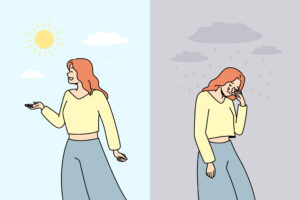Print-based advertising can communicate a brand’s identity and ethos in uniquely creative ways, and is still hugely powerful in 2022.
The numbers prove it:
- Interestingly, 82% of customers trust print ads the most when making a purchase decision.
- Print can enhance digital. For example, campaign effectiveness jumps by 400% when digital and direct marketing materials are combined.
- Younger audiences are also receptive - a staggering 92% of young adults aged between 18 and 23 say print is easier to read than digital.
With frustration at digital and video ads growing, print creative can recapture attention. Here are some latest examples of campaigns doing that effectively.
Bumble, #MakeRomanceEqual

The dating app created a unique print ad that depicted the tired etiquette of dating through a fake in-app direct message conversation.
The messages tap into common dating tropes, such as waiting three days to text back and arriving to dates 20 minutes late to not seem overly interested.
Utilising Bumble's recognisable yellow and white branding, this witty print ad aimed to challenge the formalities of dating with the tagline: “The rules of dating are so weird. Let’s break them”.
Copywriters Oli Beale and Alexandre Holder successfully expose the unfair expectations put on both parties during dating scenarios in a sharp, inventive way.
The use of faux DMs gives the print ad a level of authenticity that viewers may find relatable and humorous, fitting the theme of the brand’s previous ad “The Romance Gap”, a 90-second YouTube film launched in March 2022 addressing gender-based dating expectations.
Burger King, Meat?

In a creative attempt to promote its meatless offering, Burger King recently confused meat-lovers with its 2022 Plant-Based Whopper ad.
Using a close-up image of what appears to be animal meat but is actually red pepper, beetroot and radicchio, the series of ads in the “Meat?” campaign uses clever photography to showcase the visual commonalities between vegan and animal-based products.
“Meat?” demonstrates the brand’s propensity for fun, tongue-in-cheek humour and smart advertising, which gets it noticed.
When it comes to print-based advertising, sometimes it’s the photography that takes centre-stage, and the simplest of concepts can help to drive sales.
When the ad was released in March 2022, Google searches for Burger King vegan options saw a spike.
McDonald’s, Take Away Your Takeaway

This campaign saw McDonald’s take ownership of the fact its packaging accounts for a significant amount of littering in Norwegian cities.
It sought to encourage customers to reduce their littering. Striking yet unpolished photography exposes the reality of the issue, pairing discarded McDonald’s packaging on the streets of Oslo with simple, to-the-point copy:
“Unfortunately, too much of our packaging ends up on the streets. Now we’re doing our biggest effort yet and will clean even more than we already do”.
Deployed across print, social media, out-of-home displays and even McDonald’s restaurant trays, Take Away Your Takeaway is a prime example of a brand speaking out on societal issues and change while mobilising its own customers across channels.
Lacoste, Ageless

With its 2022 billboard, TV and social media campaign, luxury fashion brand Lacoste demonstrates fashion can be embraced by all generations.
Agency BETC created a series of advertisements featuring individuals from different generations and walks of life realising they are wearing the same Lacoste clothing.
The ads mostly feature people who had not modelled previously, providing an air of authenticity and relatability.
Through warm, vibrant photography, the series evokes a positive feel, making it perfectly suited to a summer campaign.
By including everyday people of different ages through street casting, the brand doesn’t just limit themselves to one target audience and instead emphasises that all ages can feel confident in the Lacoste brand, making it their own.
Lovehoney, Ogle

When Google introduced its SafeSearch explicit-results filter, a challenge was posed to sex products e-tailer Lovehoney. According to the firm, 700,000 adults were prevented from finding the brand's site in just two months.
Lovehoney decided to take matters into its own hands using the undisputed power of print advertising.
The “Ogle” campaign uses the unmistakable colours of Google’s branding to urge customers: “Turn off SafeSearch to lay eyes on our full range."
“Ogle” reveals how brands, in print, can use plays on words, even invoking other brands' own iconography to get noticed, whilst addressing key issues such as SEO barriers.
Takeaways
From the innovative, fearless campaigns listed, one thing is clear - strategic creative print ads can result in commercial success and heightened brand awareness.
Compelling visuals, such as thought-provoking photography and short, snappy copy, are always best for print campaigns, helping to instantly captivate the audience and hold their attention.
By taking a bolder approach and discussing topical social and environmental issues in print-based ads in unexpected ways, brands let readers know that they have strong core values which help to keep them in the forefront of their target audience’s minds.










